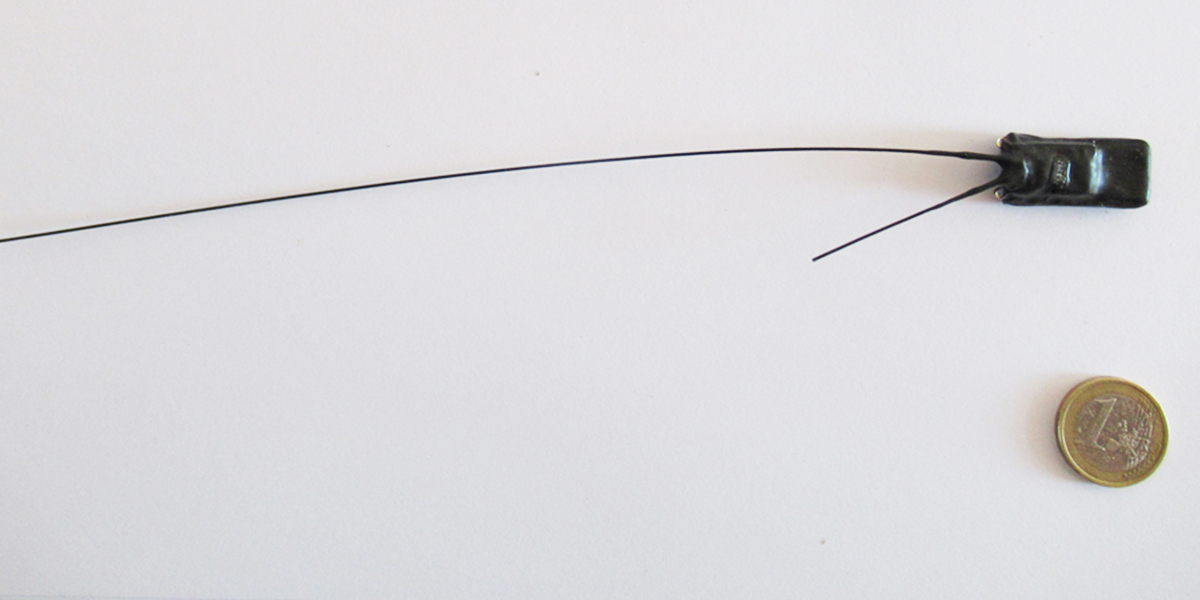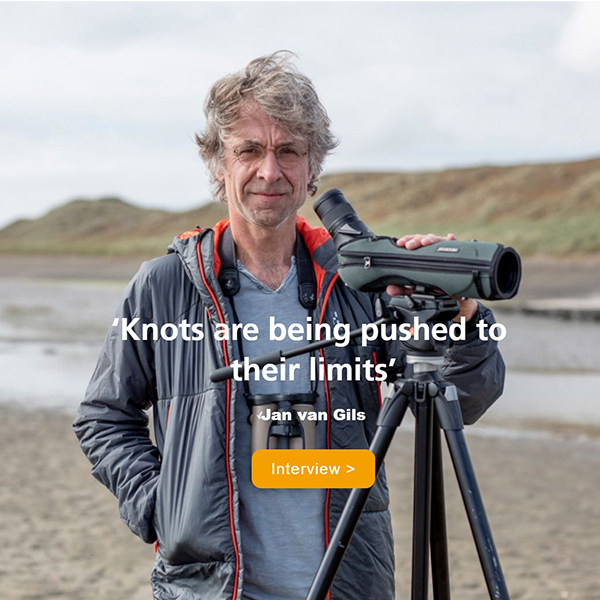Blog 5 | Joint departure of Team Van Gils and the satellite-tagged red knots from Banc d’Arguin to the Netherlands
May 12 - by Eva Kok and Tim Oortwijn
As explained in our previous blog, we prolonged our expedition to be able to record red knots depart on northward migration. In the first days of May we observed more and more departing waders. Among them a few red knots. At the same time, we continued to find our satellite-tagged red knots during our daily surveillances on the mudflats, confirming that the knots had not yet left the area. This gave us extra opportunities to collection behavioural- (film) and dietary (droppings) information on the tagged individuals.
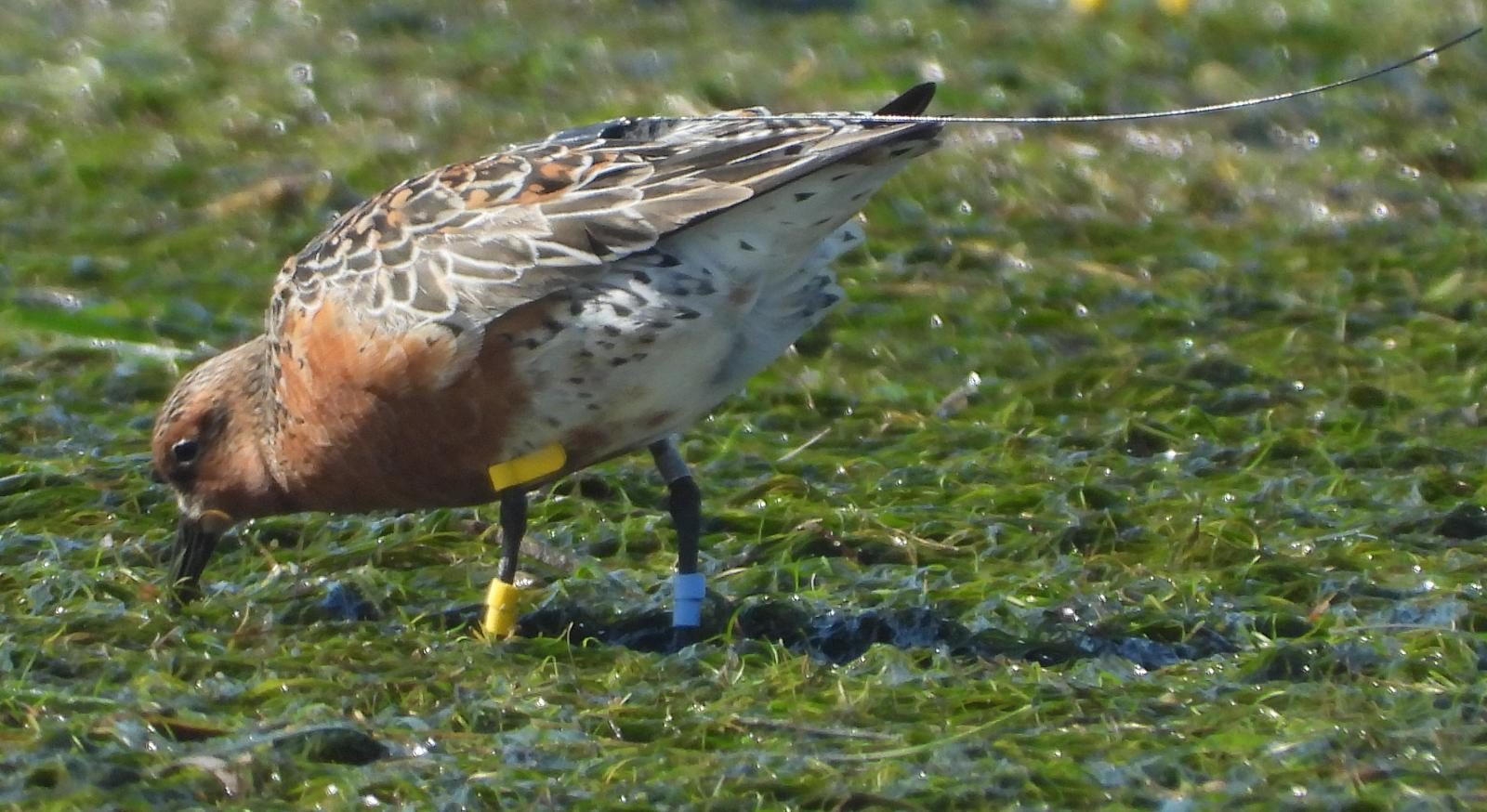
Inevitably our last day at the field station in the Banc d’Arguin came. After a long day of cleaning and packing our gear we made a last visit to the nearly located high-tide roost named Abelgh Eiznaya. We strategically positioned ourselves with binoculars and cameras on a higher located part of the beach in between the roost and the sea. And then we waited…..But not for long!
While the water was coming in and the sun was setting, the sound of red knots calling reached us. They were clearly getting excited and so were we! Suddenly the first group of about 40 individuals shot into the air; quickly gaining elevation while calling for their mates on the group to follow. Leaving us exhilarated on the ground! That evening we witnessed multiple small groups take-off, with their departures undeniably indicating the onset of migration. Leaving us with the peace of mind to leave Banc d’Arguin too.
Little did we know that our paths would cross again with the satellite tagged knots before we knew it. While we flew from Nouakchott (the capital of Mauritania) to Paris, the satellite tagged red knot named Arkeiss simultaneously flew a few kilometres below us to the French coast near La Rochelle. By the time we landed on Schiphol red knots R’Gueba and Abelgh Eiznaya reached the island of Schiermonnikoog in the Dutch Wadden Sea. We cannot wait to follow their subsequent movements along the European coastlines and onward to the Russian breeding grounds. You can follow them too on: https://www.globalflywaynetwork.org/flyway/east-atlantic-flyway-coastal-waders/map.
Blog 4 | Delayed Migrations
May 3 - by Jan van Gils and Eva Kok
Our main focus during this expedition is the departure of the red knots on northward migration. To gain insights in the timing of this event, and the preceding (foraging-) behaviour before departure, we daily observe the red knots equipped with satellite transmitters on the mudflats. In the past weeks we witnessed how their plumage turned brighter red every day and their abdominal profile (and indication of the amount of fat stored) increased to maximum sizes.
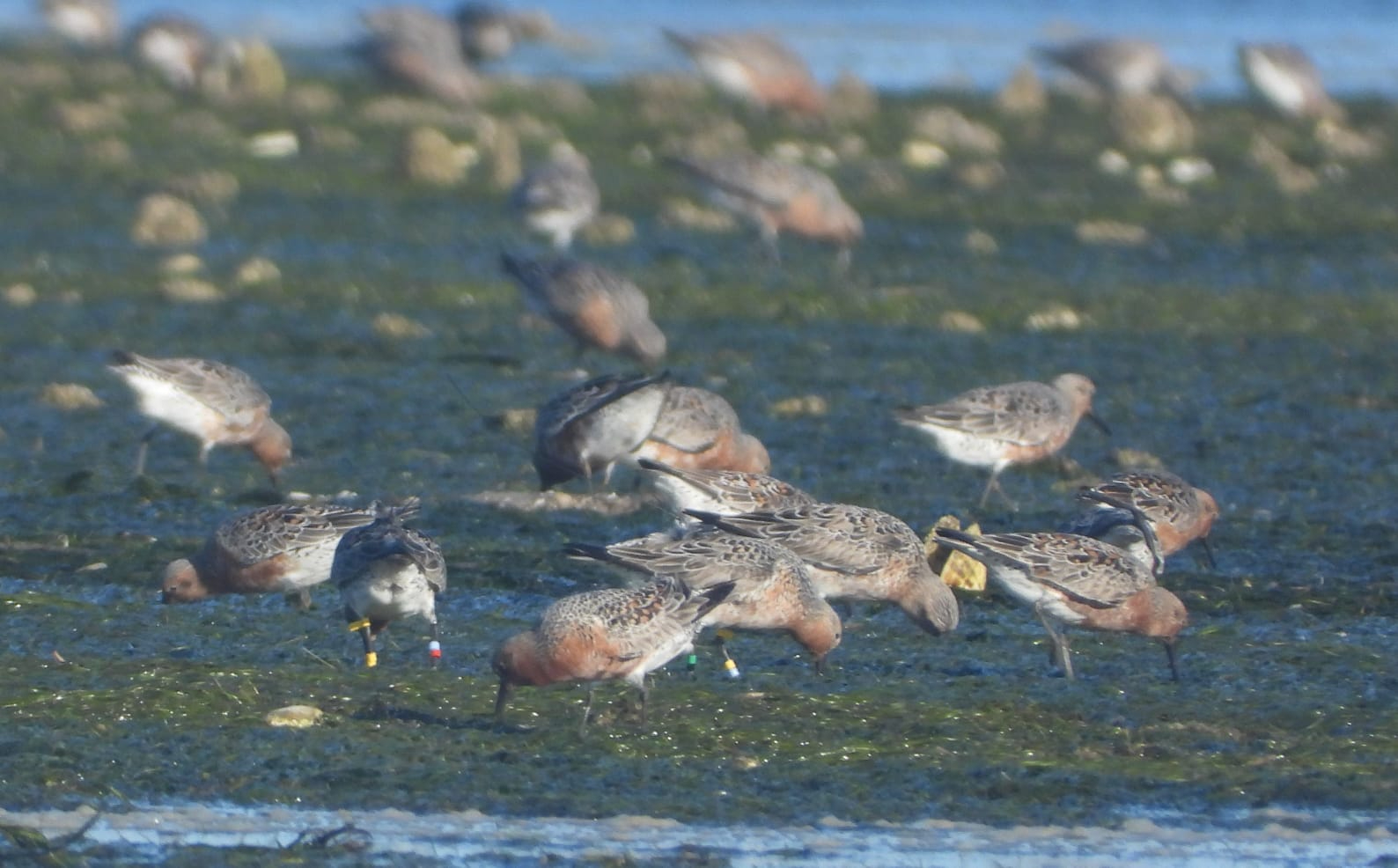
Based on large scale counts of migratory departure of waders in the Banc d’Arguin in the late 1980s and 1990s revealed that red knots leave the Banc d’Arguin on northward migration between the 25 April and 11 May. The largest flocks of red knots have been observed to depart around 2 May. With the effects of global warming in the back of our minds we assumed that the knots would depart at the earliest convenience.
However, at the time of writing this blog, 3 May, no knots seem to have left the area. In the past week we have seen multiple flocks of other species of waders depart, but not the knots. Also, none of the red knots carrying a transmitter have departed the area. Although, we are surprised by this absence of departure it also means that we have more opportunities to find and observe our knots in the field. To be able to witness the red knots depart we have decided to delay our own migration north by pushing our return flights forward.
You can also follow the movements of the tagged red knots on: https://www.globalflywaynetwork.org/flyway/east-atlantic-flyway-coastal-waders/map
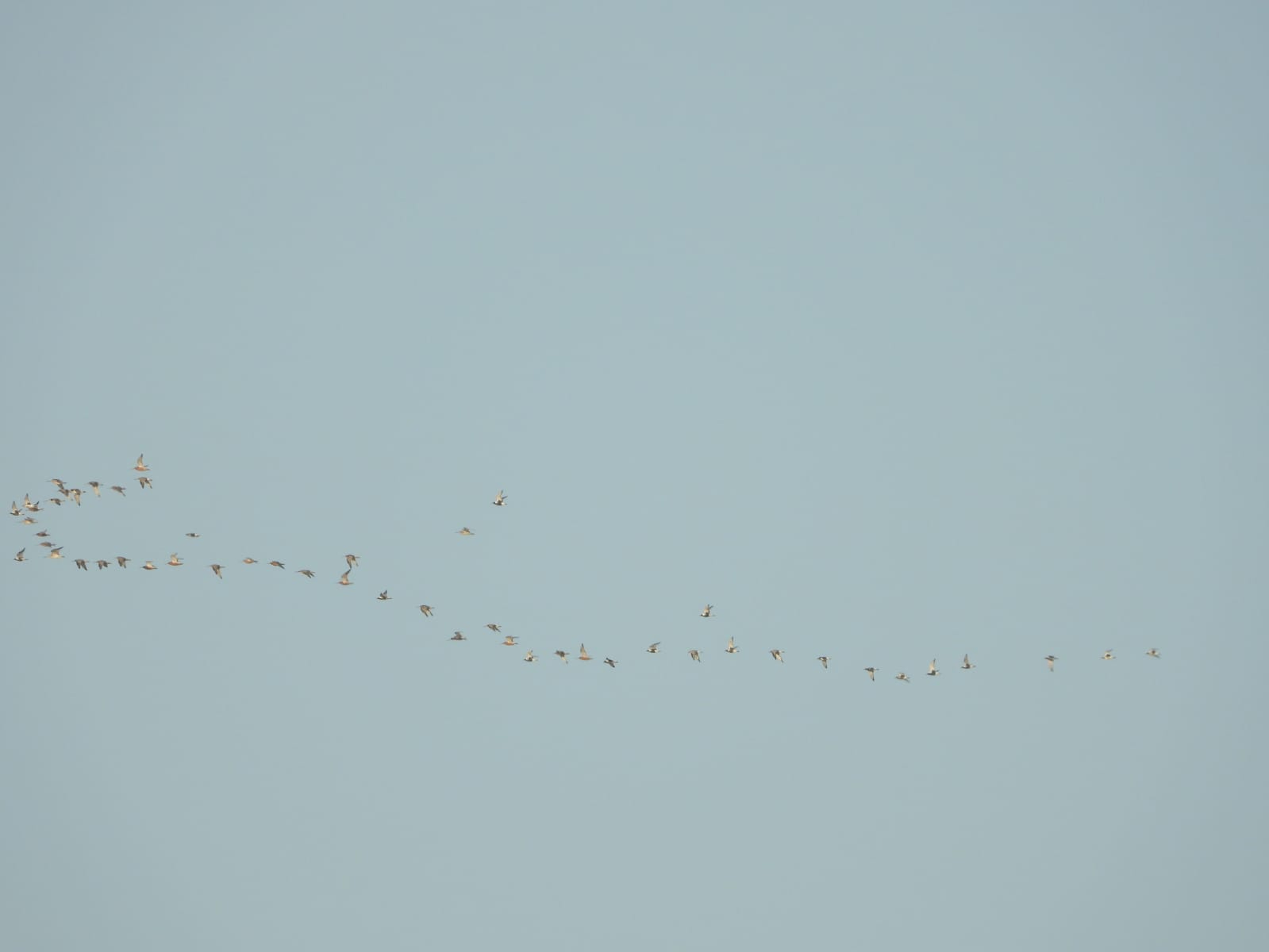
One of the research interests is the study of individual diets in relation to individual migratory performance. This involves collecting droppings and to take a benthos sample at their preferred foraging locations. How that works? Have a look on the methodology of dropping collection and benthos sampling with the photos below.
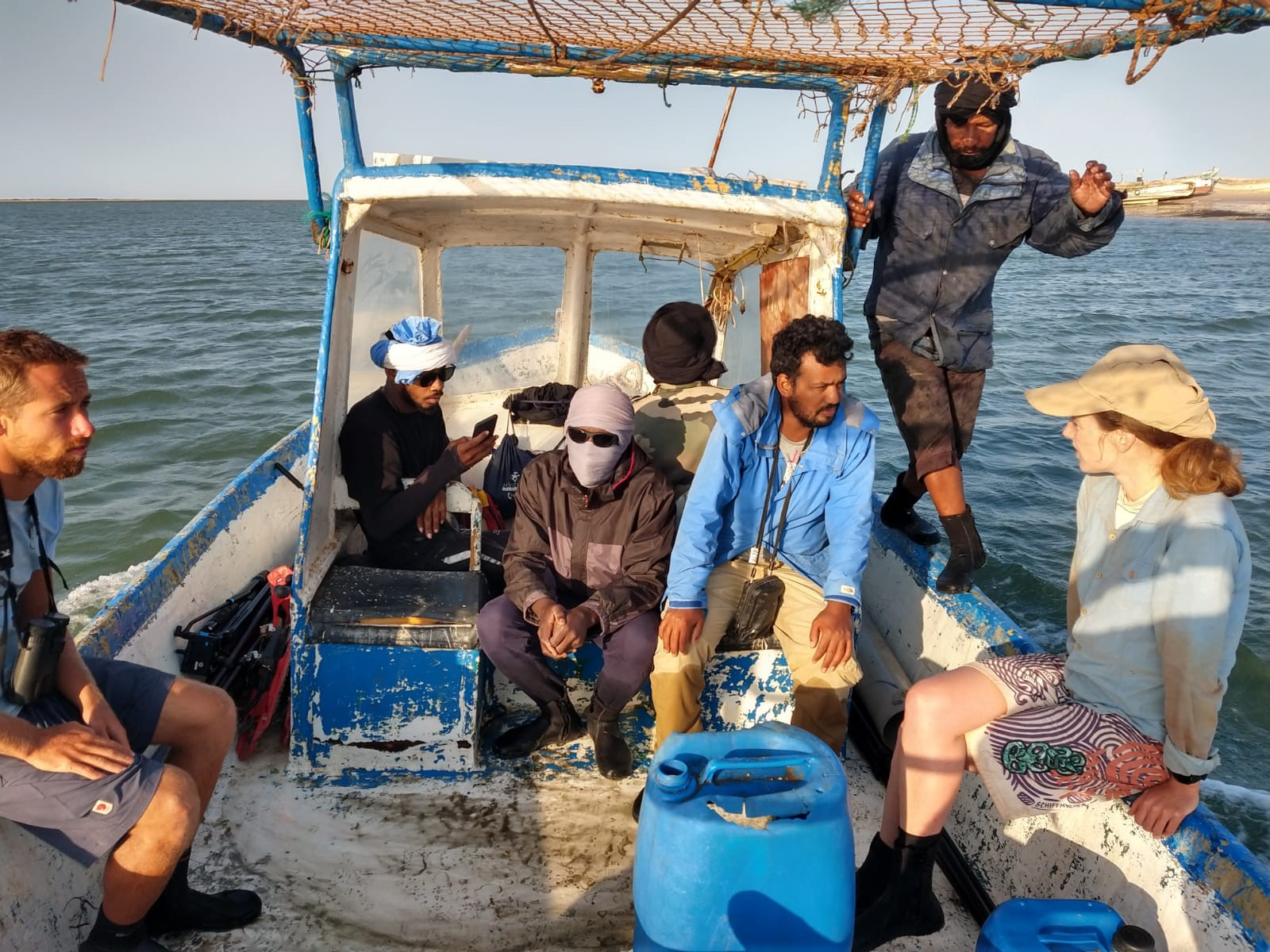
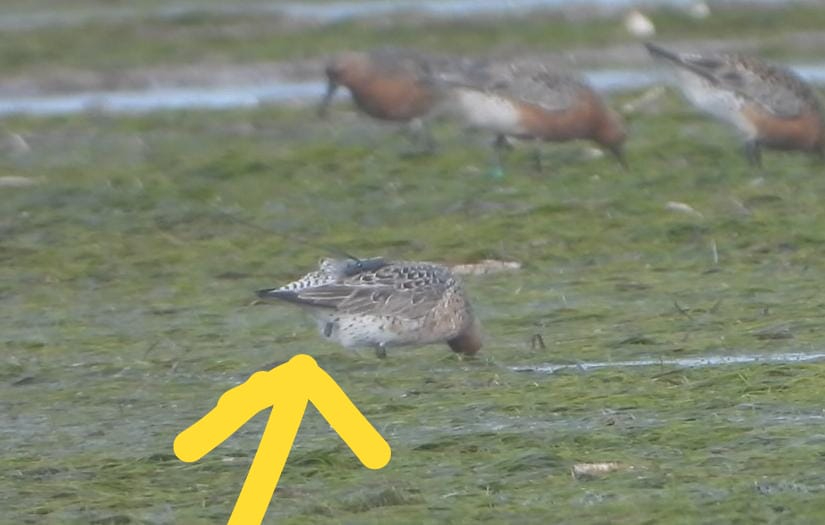
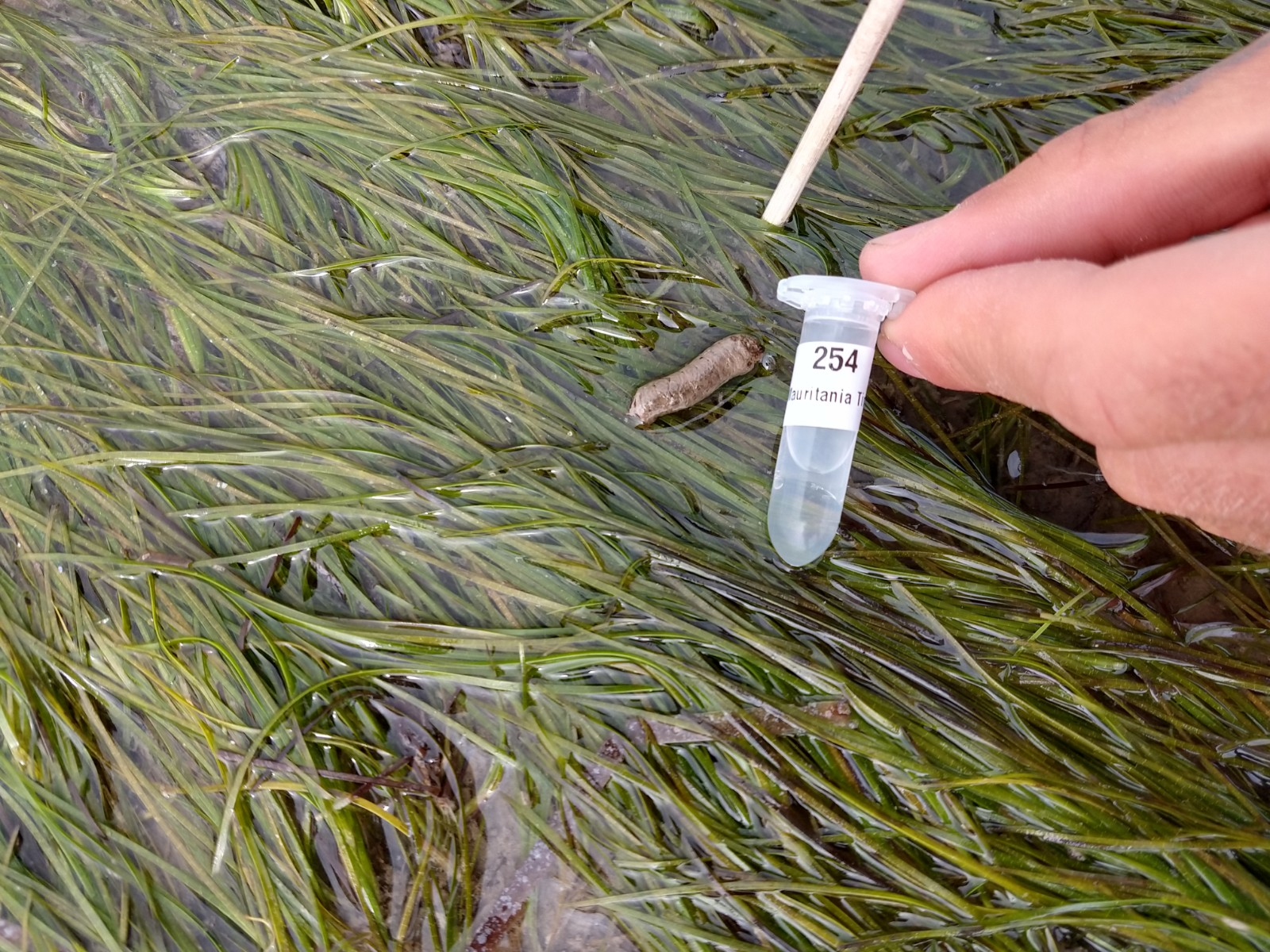
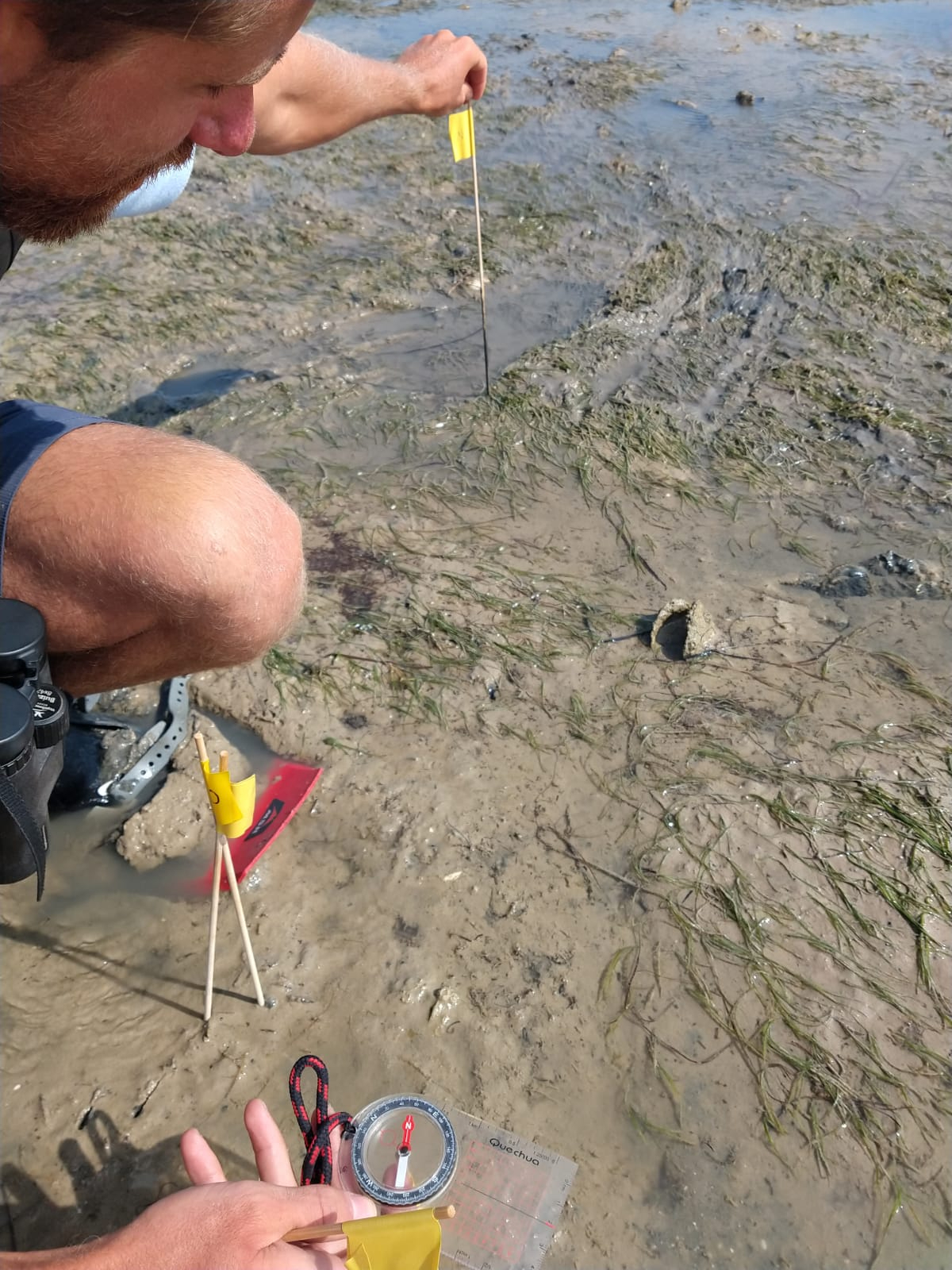
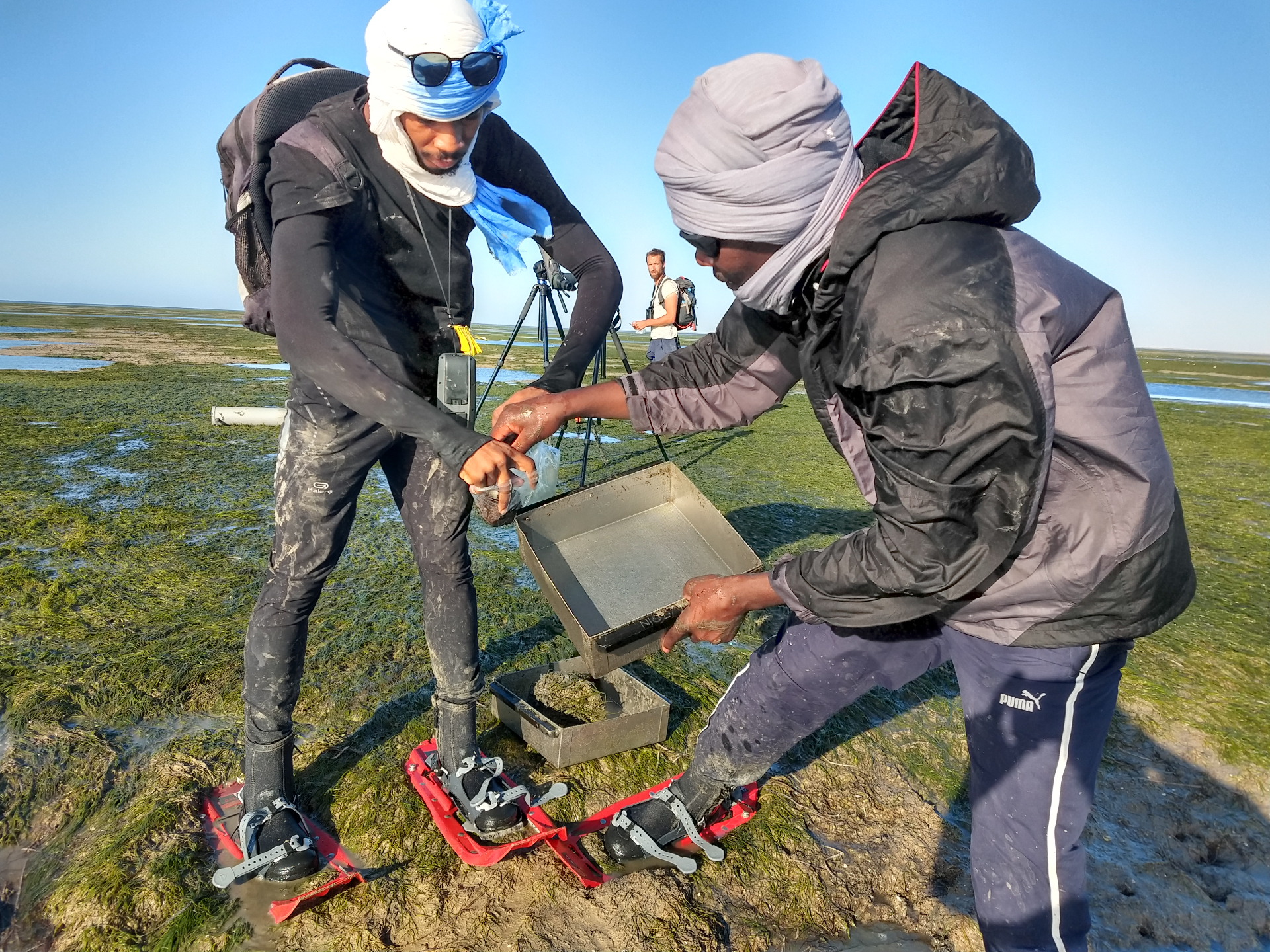
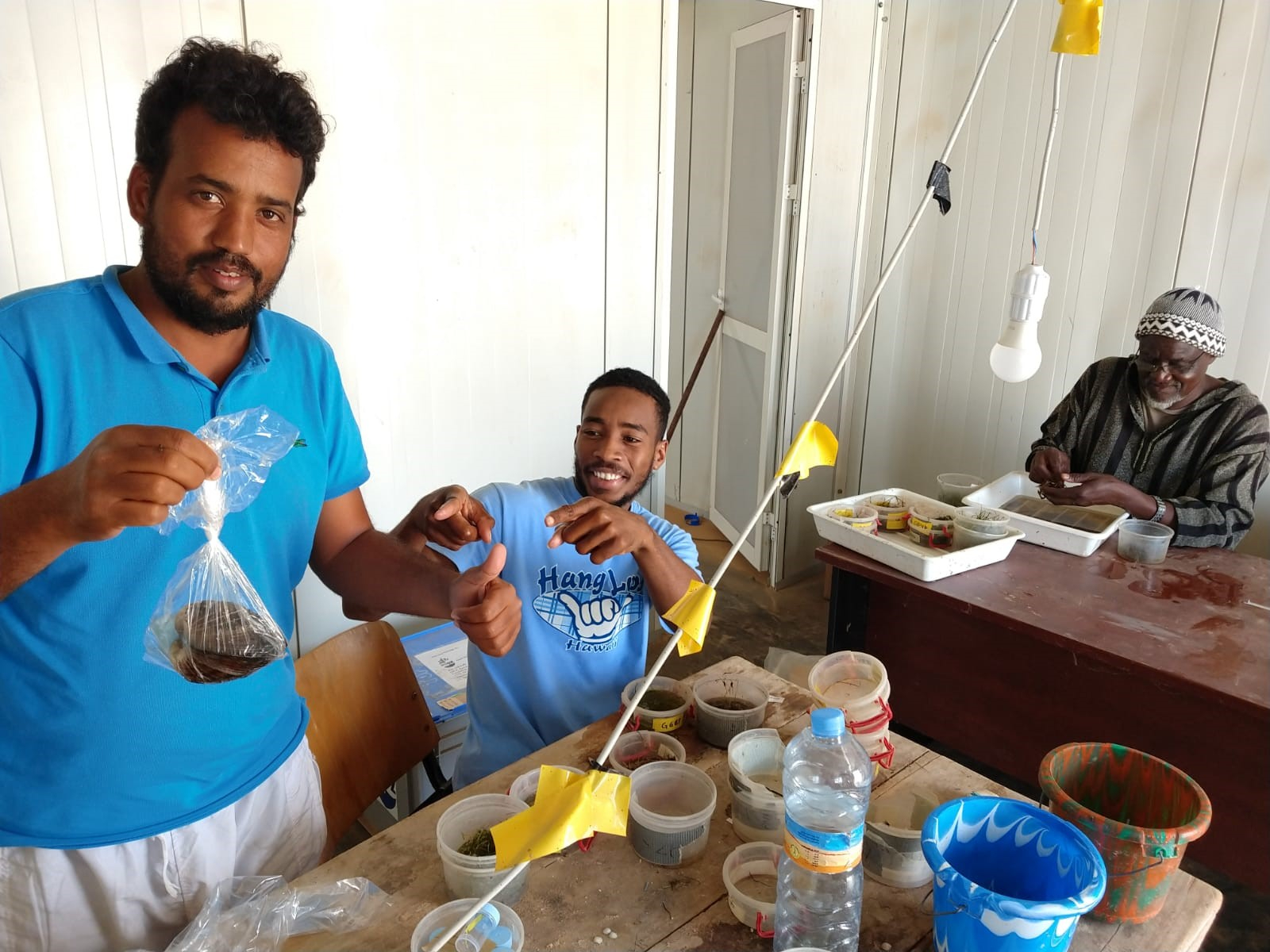
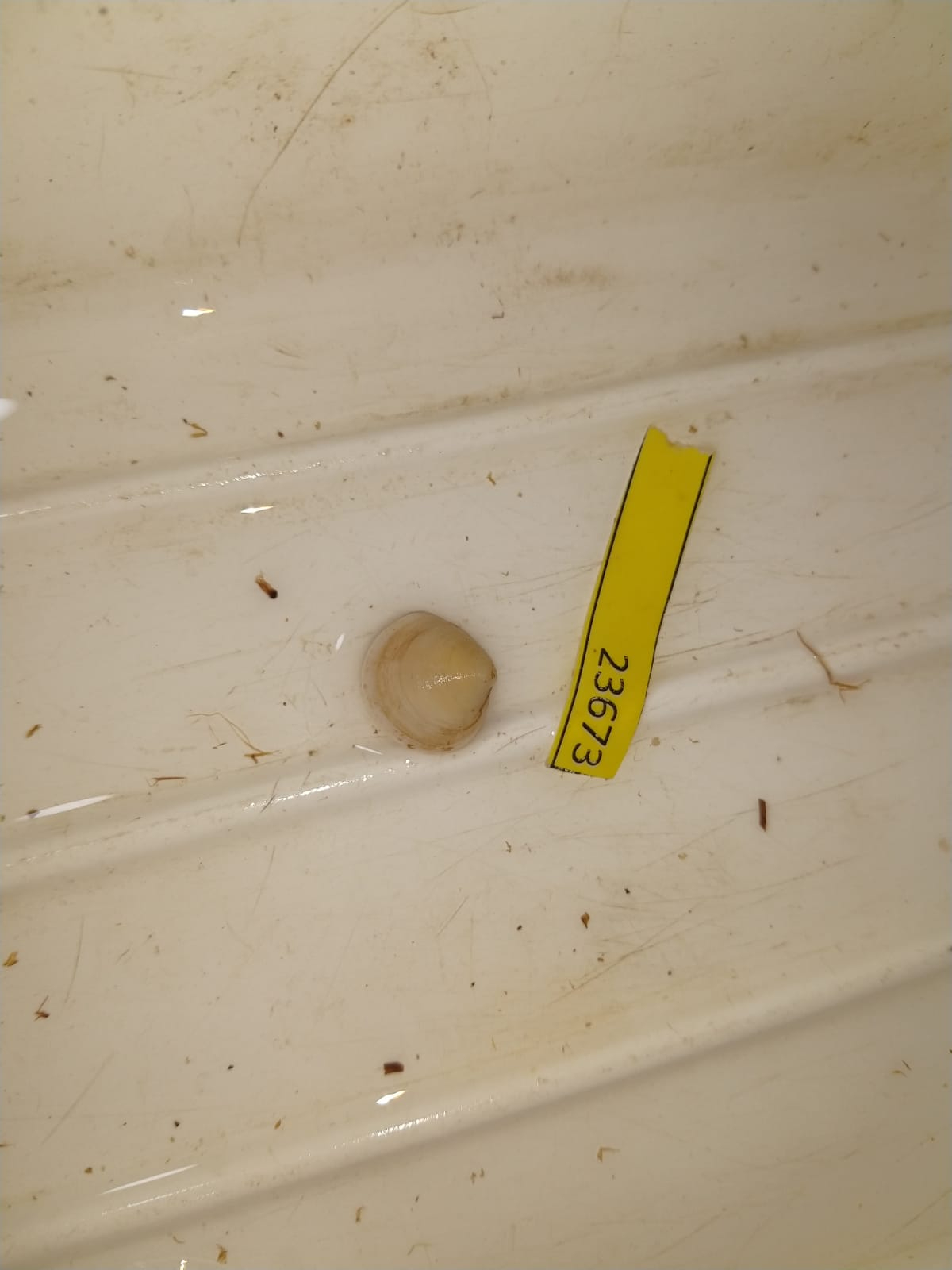
Blog 3 | Finding needles in the haystack
April 23 - by Jan van Gils and Tim Oortwijn
Now that all birds have been caught, satellite-tagged, and released, our primary aim for the remainder of the expedition is to find back the tagged birds in the field for additional measurements. This is a challenging task. With 36 knots flying around with a thin antenna sticking out amidst 10.000 conspecfics, the search almost literally feels like the search for a needle in a haystack. Nevertheless, we manage really well, with finding 3-4 birds on a normal day. Once a satellite-tagged bird has been found we record its feeding behavior, score the degree of summer plumage, and assess the bulkiness of its abdomen (the latter as a measure of fat stores). A small photo overview of the progress of the expedition in this third blog.
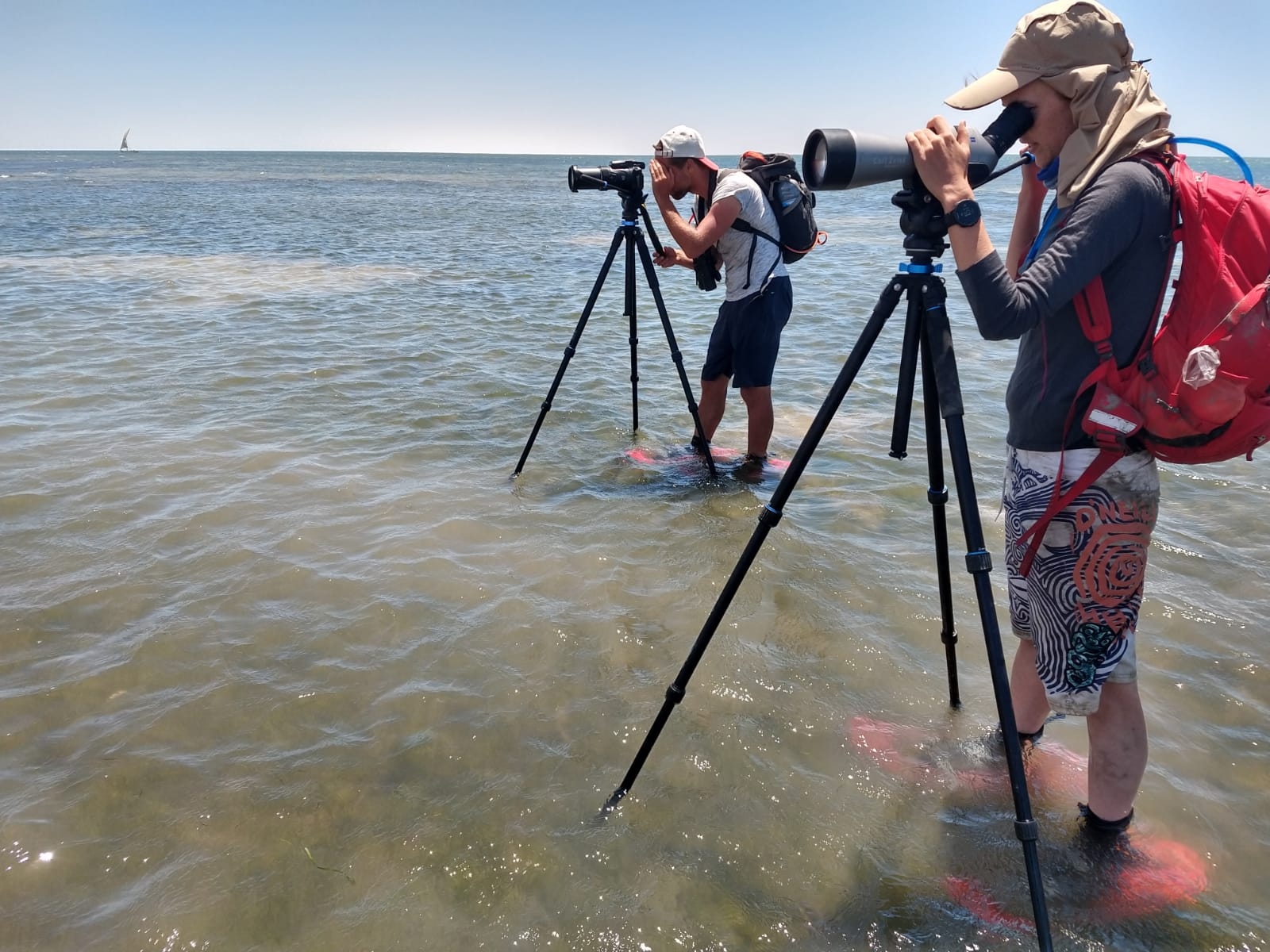
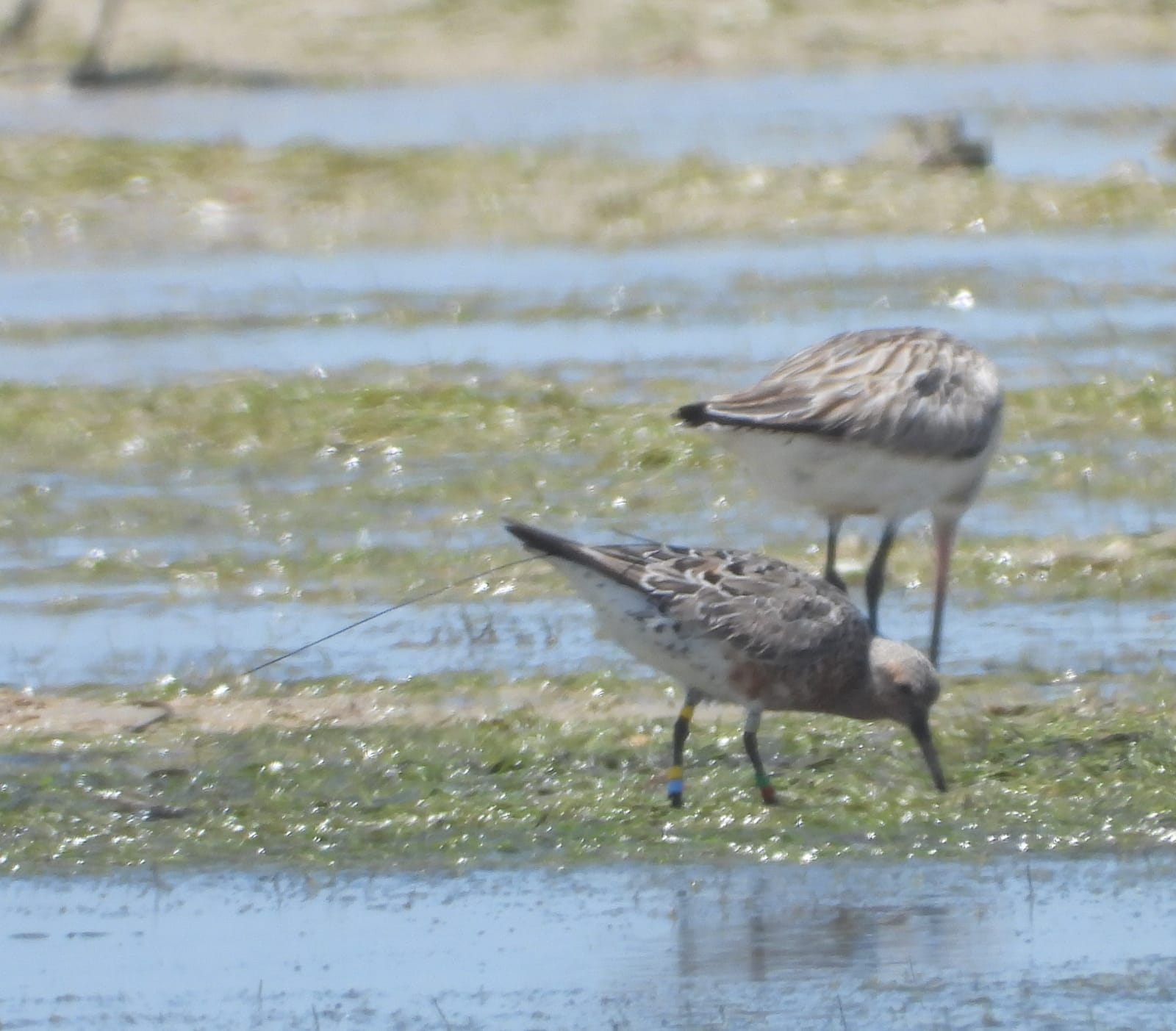
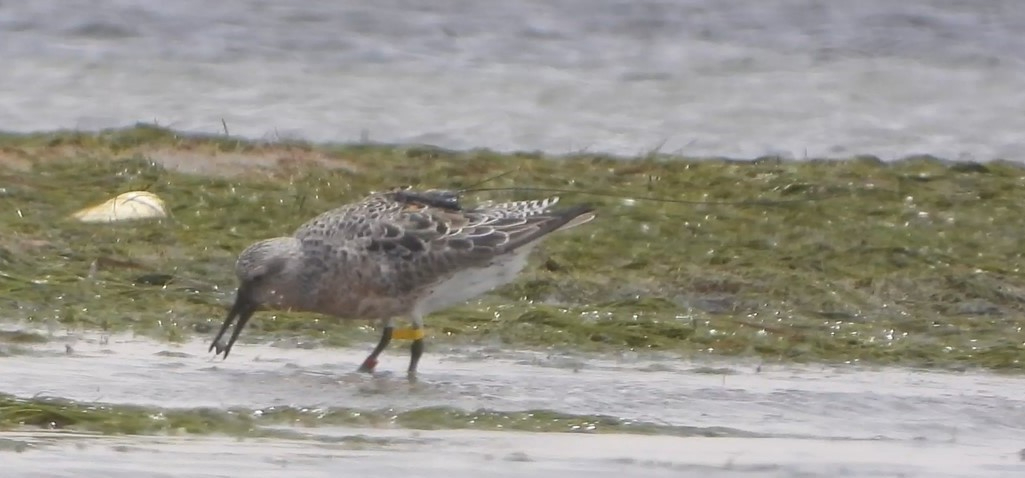
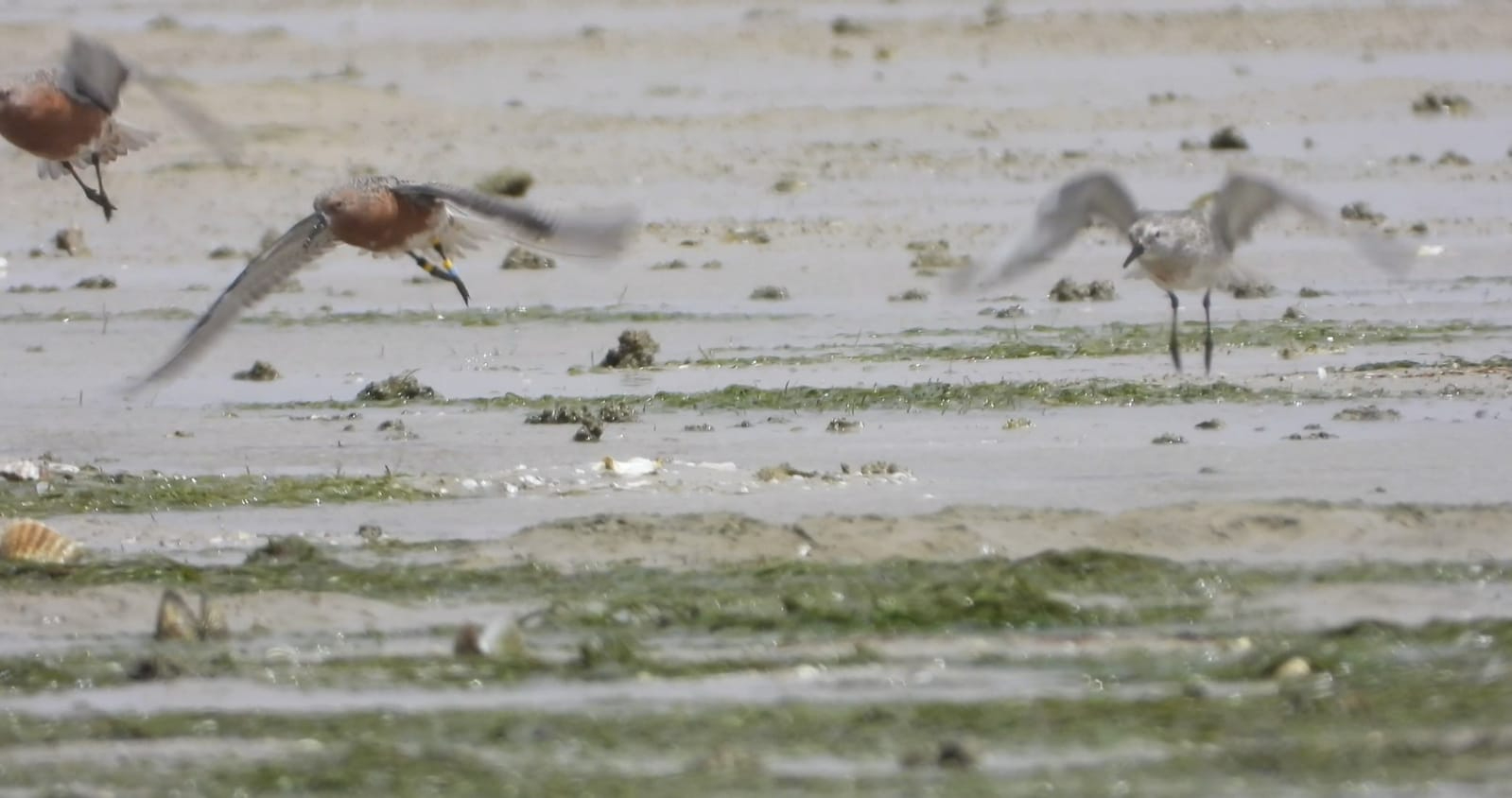
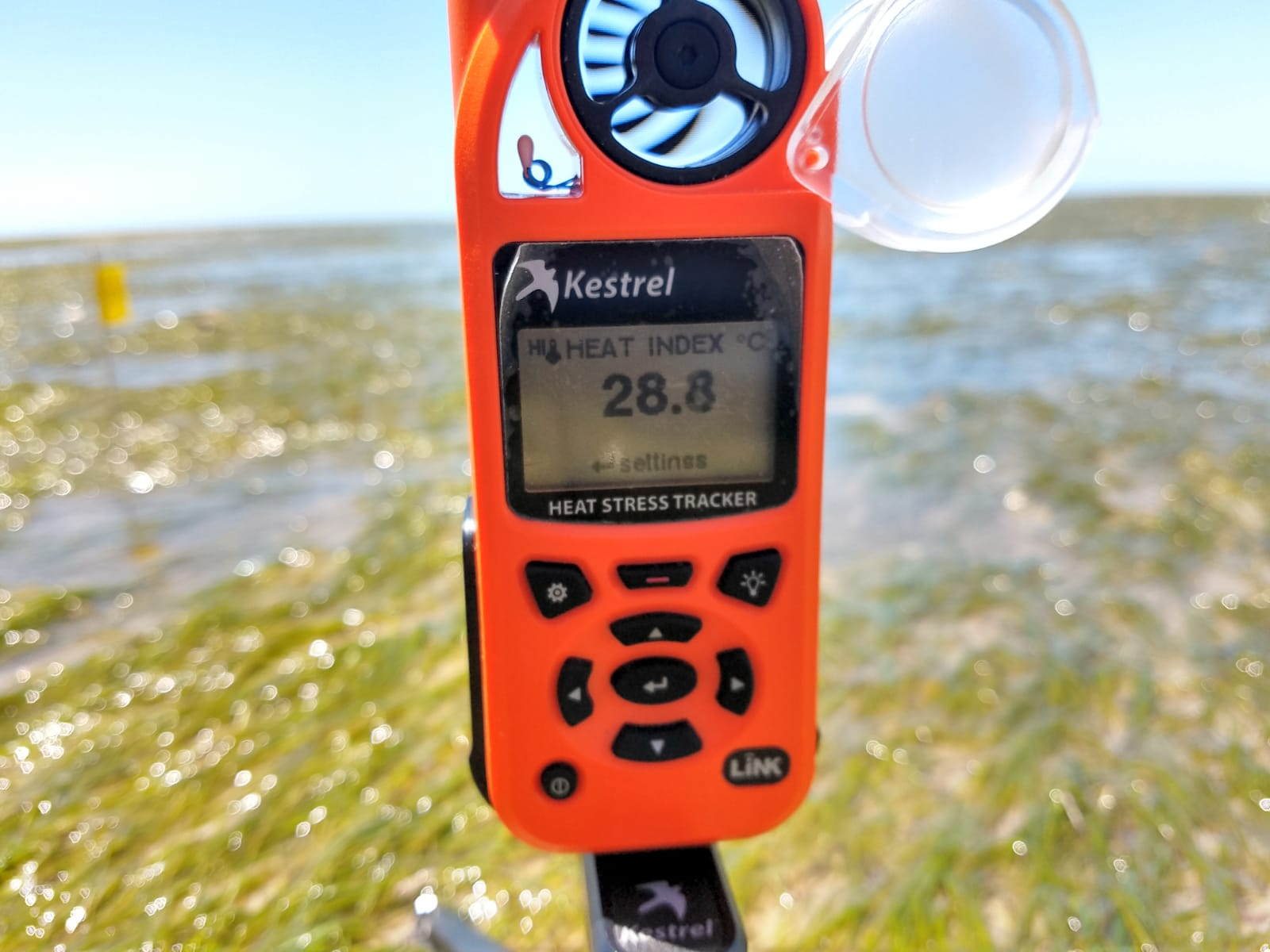
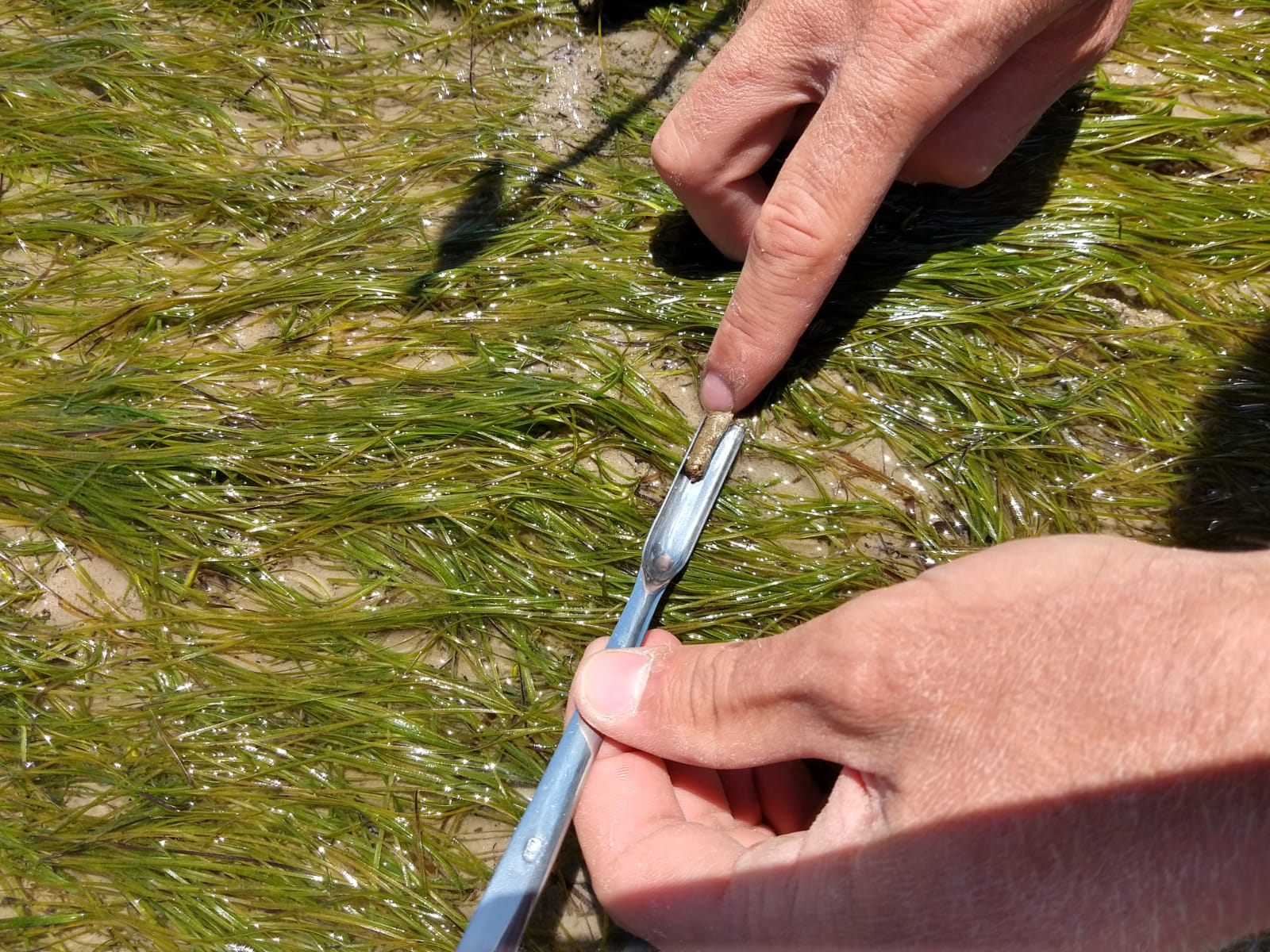
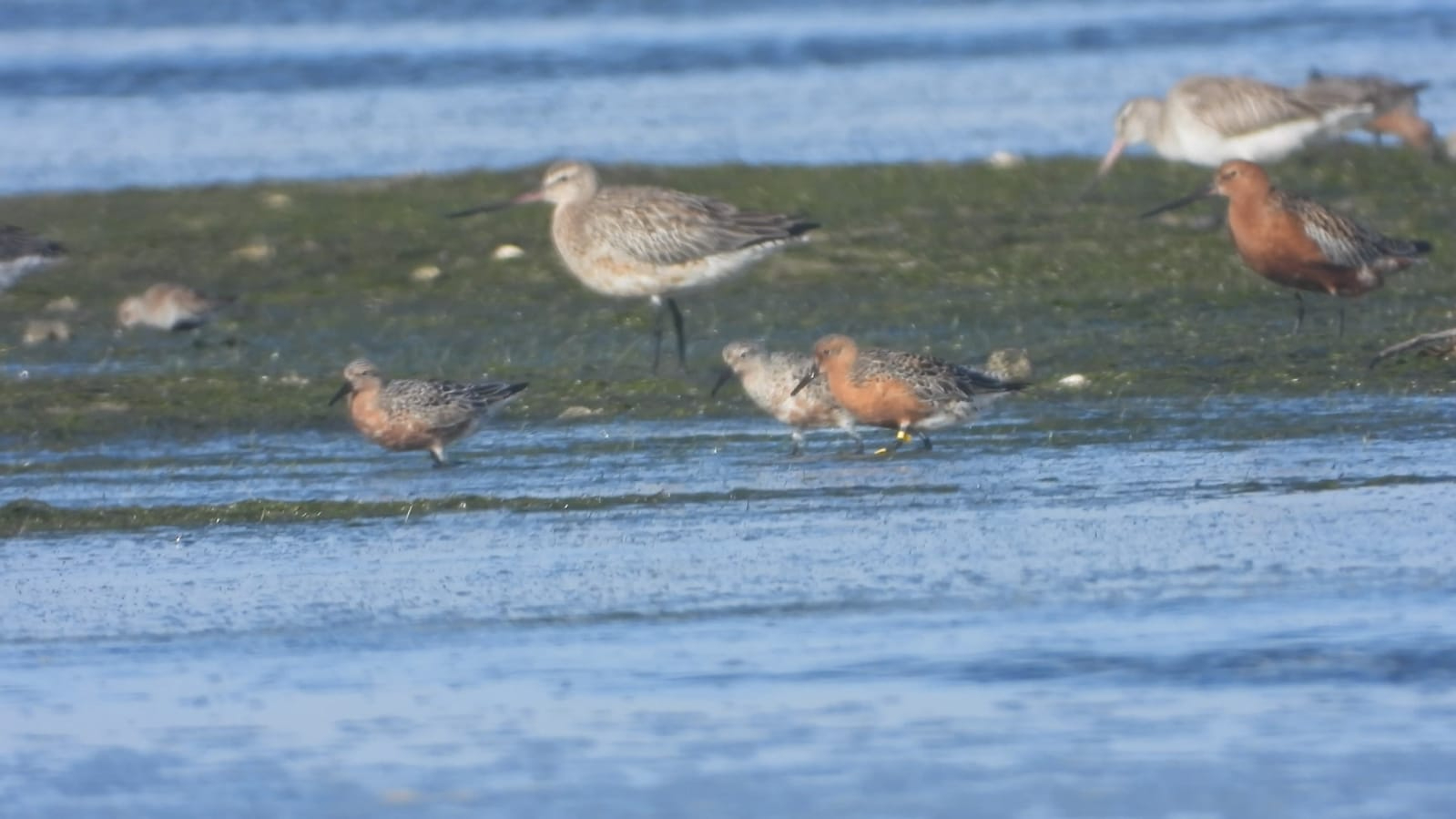
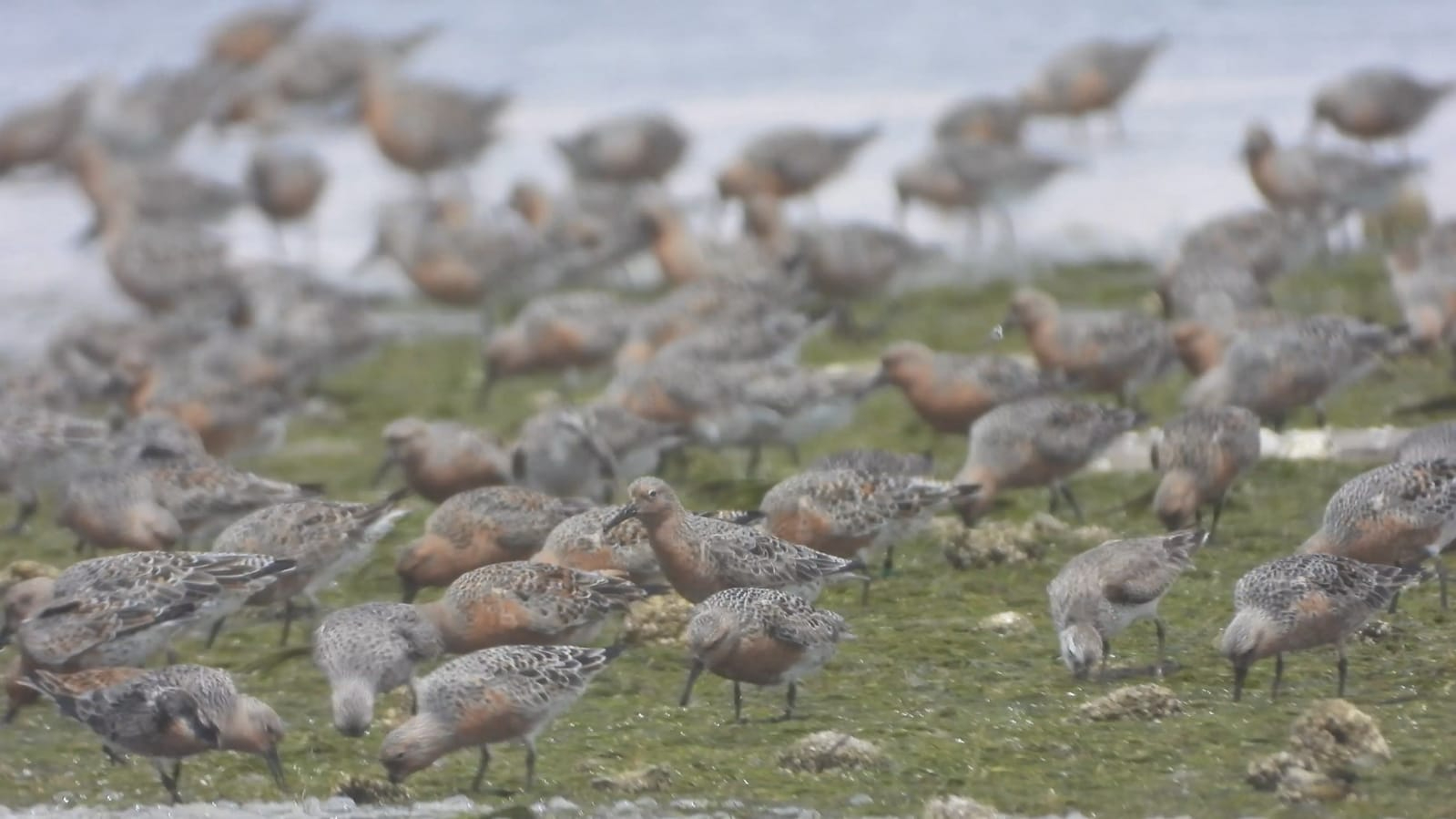
Blog 2 | A dream start!
April 16 - by Eva Kok & Jan van Gils
Jan van Gils and his team are now almost two weeks in the village of Iwik in Parc National du Banc d’Arguin in Mauritania. After a smooth trip from Texel to the West-African coast, they have had a very successful start of the expedition which you can read more about in this second blog.
Red knots are equipped with satellite transmitters
To investigate if and how knots are able to adjust the timing of their spring migration, our primary goal of this expedition is to equip a group of knots with satellite transmitters; this will allow us to follow their northward migration remotely from the mudflats of Banc d’Arguin to the tundra in Russia.
So, after installing ourselves at the fieldstation we spread out over the mudflats by boat and foot to make an inventory of suitable bird catching locations. After observing the tidal rhythm and the movements of the knots we decided to set up a section of mistnets on a high-tide roost named Abelgh Eiznaya. Mistnets can be used to catch shorebirds that are pushed from the lower foraging sites on the mudflats to the higher located roosts when the tide comes up during the night.
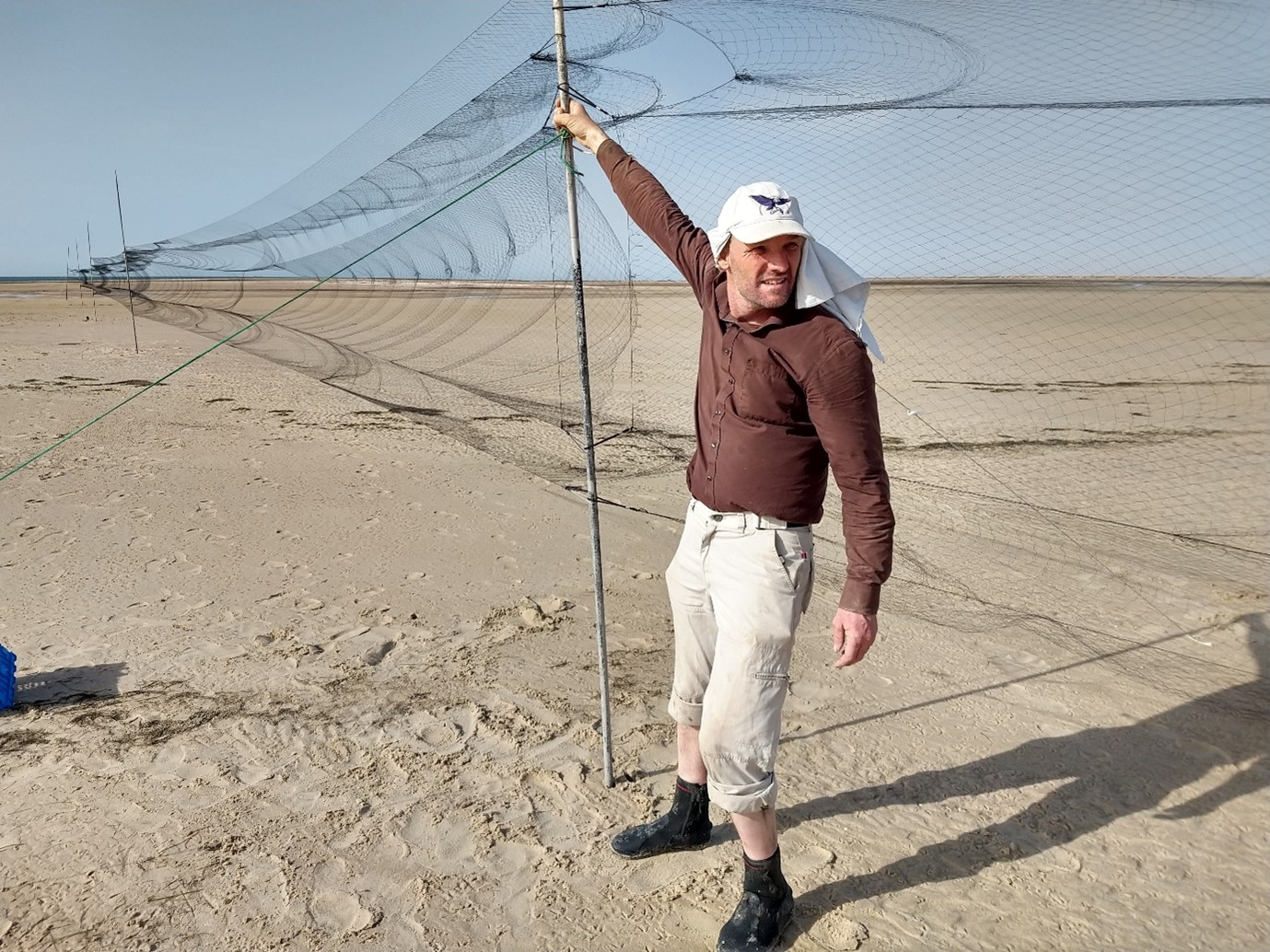
This may sound easy but in practice it is a tricky business as all catching activities take place in the night. The vast scale of the mudflats in combination with the relatively short nets, the variable wind- and tidal conditions and the occasional African Golden Jackal make for a real challenge. Fortunately, Anne Dekina en Job ten Horn together have more than 25 years of experience with catching knots in the area. Added to that, the nearly lifelong catching experience of Kees Oosterbeek, we were able to catch 12 red knots during our very first night in the field. The first knots could be released with transmitters the next day! And our luck didn’t end that night; we have been successfully catching red knots during every night in the past week, adding up to a total of 200 knots at this moment. As a consequence, 30 satellite tagged red knots are flying around on the mudflats of Banc d’Arguin. In the coming days, before the knots depart on their northward migration we will follow these birds on the mudflats to observe their (foraging-) behaviour and sample their diet. You (!) can also follow their movements on: https://www.globalflywaynetwork.org/flyway/east-atlantic-flyway-coastal-waders/map
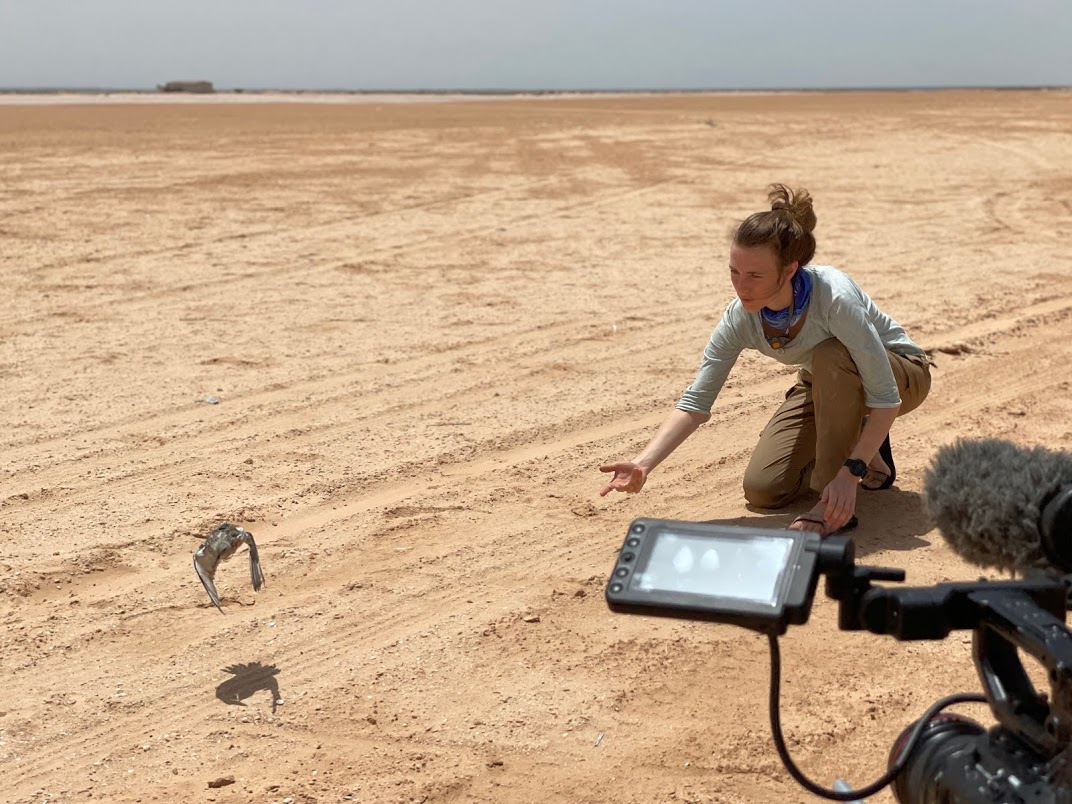
International team prepares movie called Flyways
We, ecologists, are not the only one interested by the long-distance migrations of the red knot. Randall Wood and his international team are preparing a movie called Flyways about the magnificent migration of shorebirds worldwide. During this expedition they will film everything that is related to the red knots and our work. However, the Mauritanian mudflats are very muddy, and one easily sinks into the mud knee deep or more. Snowrackets allow Jan en Tim to walk on the mudflats in search for the knots, without sinking into the mud too deeply. As we learned this week, this is much more difficult while carrying a very heavy camera. While trying to keep up with the lighter-packed researchers the camera crew got stuck in the mud with their equipment on more than one occasion. Due to the many successful catches and the early release of satellite tagged red knots, fortunately, they had plenty of opportunity to shoot the footage they needed.
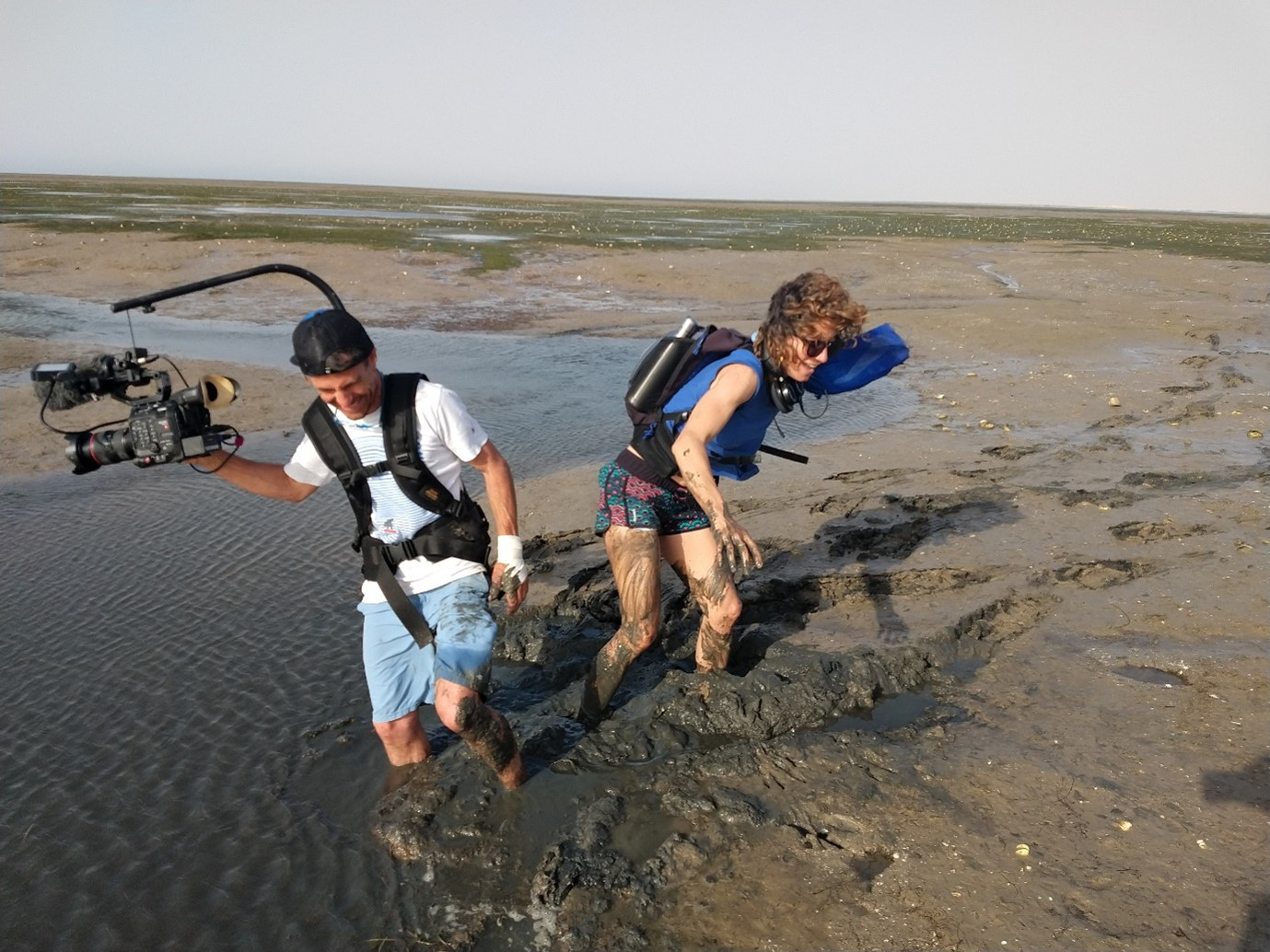
With that we come to the end of a very successful week of red knot catches. In the coming weeks we will focus on locating our satellite tagged birds on the mudflats to investigate how much, and what kind of food they eat. At the same time we will roll out an experiment with a small group of captive red knots to investigate if the addition of large amount of food allows individuals for an early departure to the breeding grounds.
Blog 1 | How to adjust travel plans in a changing world?
April 6 - by Eva Kok
The Earth is warming most rapidly around the North Pole. The birds that breed there spend the winter much further south, as far as the tropics. Using miniature satellite transmitters, a team of NIOZ researchers, led by prof. dr. Jan van Gils, are tracking 40 individual red knots “from equator to Pole” this spring to investigate whether, and how, migratory birds can adjust their travel schedule to global warming.
Global warming especially strong at the Arctic
Due to global warming, which is especially strong at higher latitudes, the snow in the Arctic melts ever earlier each year. As a result, the emergence of plants and insects (the main prey for shorebird chicks) has also advanced and this seems to induce a so-called ‘tropic mismatch’, with shorebird chicks growing up after the peak in food supply. This phenological shift may have major consequences for migratory shorebirds that fly from their tropical wintering grounds to the tundra each spring to raise their chicks. The red knot (Calidris canutus) is such a long-distance migratory shorebird. In fact, the population of red knots of the canutus subspecies is in steep decline since it was first counted in 1980.
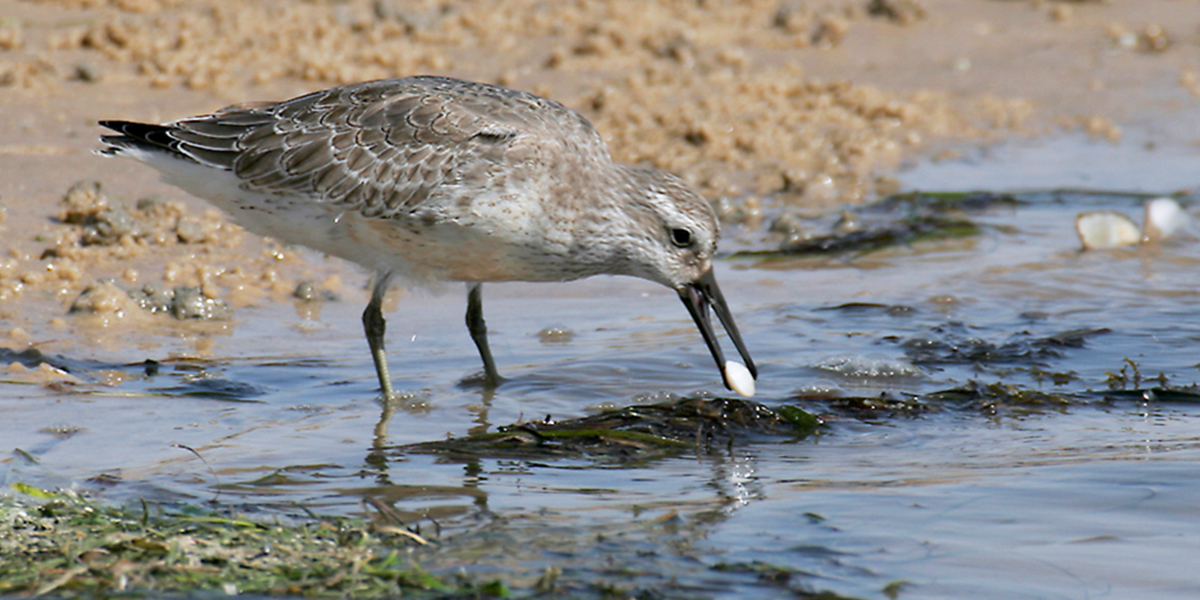
Red knots from the equator to the pole
The red knots of the C.c. canutus subspecies spend most of the year on the intertidal mudflats in the Banc d'Arguin in Mauritania (West Africa). In spring, the red knots migrate from the Banc d'Arguin, via the Wadden Sea, to their tundra breeding grounds on the Taimyr Peninsula in far northern Russia. During the short arctic summer red knots depend on the abundance of insects to feed and raise their chicks.
Are red knots able to adapt to Arctic warming?
Due to global warming, the snow on the Taimyr Peninsula melts on average more than two weeks earlier today than it did some 30 years ago. With that also the availability of insects has advanced considerably. One potential mechanism to deal with the advanced Arctic phenology for red knots is to advance their own breeding season. Contrary to expectations, recent observations of migrating red knots suggest that they do not (sufficiently) advance the timing of their northward migration accordingly. One of the hypotheses is that red knots are limited in their ability to advance the timing of their northward migration due to restricted fueling rates at their tropical wintering grounds.
Satellite transmitters reveal migration strategies of red knots
To assess whether timing and duration of migration is flexible, and indeed limited by food availability, we will equip 40 red knots in Mauritania with satellite transmitters and follow their subsequent migrations. Before the start of migration, red knots physically prepare for the effort by doubling their body weight by means of energy rich fat stores that serves as fuel for the long flight. To build up so much fat, red knots have to eat an awful lot in the weeks before departure. However, in the wild their food intake is limited by the amount of accessible prey and the trade off with other activities such as predator avoidance.
To investigate if red knots are able to advance their northward migration when foraging restrictions are released, we will provide a group of 10 red knots with ad libitum food in a safe environment. This treatment enables the red knots to quickly build up enormous fat reserves. These fat reserves should, in theory, allow the red knots to begin their northward migration earlier than the control group that is required to gain their energy stores independently on the intertidal mudflats.
In the first few days after release, we will follow the red knots on the intertidal mudflats in the Banc d’Arguin to record their food intake rate, collect their droppings and to take a benthos sample at their preferred foraging locations. With these additional measures we will be able to place individual differences in migratory behaviour observed through the satellites in a broader ecological context.
By the end of April, the red knots depart on their long journey north. Starting then we will keep track of the red knots behind our desk. We are primarily interested in the difference in timing between the ‘control’ group (only equipped with a satellite transmitter) in comparison to the treatment group that on top of the transmitter received unlimited amounts of food. However, the transmitters are even so accurate that we will be able to observe when the red knots start incubating their eggs on the Russian tundra. Consequently, we will be able to investigate whether individual red knots are flexible in the timing of their migration when conditions allow, and what impact a possible early start to migration has on the timing and success of breeding. In this blog series we keep you updated about our experiences.
